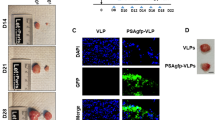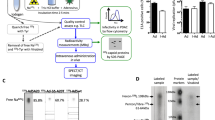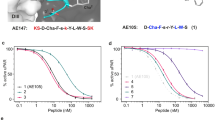Abstract
The accurate assessment of nodal involvement in prostate cancer is crucial to planning treatment, yet there is a shortage of noninvasive imaging techniques capable of visualizing nodal lesions directly. This study demonstrates the feasibility of using recombinant human adenoviral vectors to detect nodal metastases in a human prostate cancer model. This was achieved by the prostate-restricted expression of optical and positron emission tomography (PET) imaging reporter genes by the viral vector coupled with the innate lymphotropic properties of adenovirus. We show that peritumoral administration of these vectors results in the direct detection of reporter gene expression in metastatic lesions within sentinel lymph nodes. Notably, this approach parallels the current lymphoscintigraphy method but enables the direct PET visualization of sentinel lymph node metastases, eliminating the need for invasive lymphadenectomy. These findings may lead to more effective diagnostic and therapeutic strategies for individuals with advanced-stage prostate cancer.
This is a preview of subscription content, access via your institution
Access options
Subscribe to this journal
Receive 12 print issues and online access
$209.00 per year
only $17.42 per issue
Buy this article
- Purchase on Springer Link
- Instant access to full article PDF
Prices may be subject to local taxes which are calculated during checkout





Similar content being viewed by others
References
Roehl, K.A., Han, M., Ramos, C.G., Antenor, J.A. & Catalona, W.J. Cancer progression and survival rates following anatomical radical retropubic prostatectomy in 3,478 consecutive patients: long-term results. J. Urol. 172, 910–914 (2004).
Epstein, J.I., Partin, A.W., Potter, S.R. & Walsh, P.C. Adenocarcinoma of the prostate invading the seminal vesicle: prognostic stratification based on pathologic parameters. Urology 56, 283–288 (2000).
Daneshmand, S. et al. Prognosis of patients with lymph node positive prostate cancer following radical prostatectomy: long-term results. J. Urol. 172, 2252–2255 (2004).
Link, R.E. & Morton, R.A. Indications for pelvic lymphadenectomy in prostate cancer. Urol. Clin. North Am. 28, 491–498 (2001).
Heidenreich, A., Ohlmann, C.H. & Polyakov, S. Anatomical extent of pelvic lymphadenectomy in patients undergoing radical prostatectomy. Eur. Urol. 52, 29–37 (2007).
Rorvik, J. & Haukaas, S. Magnetic resonance imaging of the prostate. Curr. Opin. Urol. 11, 181–188 (2001).
Wolf, J.S. Jr. et al. The use and accuracy of cross-sectional imaging and fine needle aspiration cytology for detection of pelvic lymph node metastases before radical prostatectomy. J. Urol. 153, 993–999 (1995).
Harisinghani, M.G. et al. Noninvasive detection of clinically occult lymph-node metastases in prostate cancer. N. Engl. J. Med. 348, 2491–2499 (2003).
Giuliano, A.E., Kirgan, D.M., Guenther, J.M. & Morton, D.L. Lymphatic mapping and sentinel lymphadenectomy for breast cancer. Ann. Surg. 220, 391–398 discussion 398–401 (1994).
Morton, D.L. et al. Sentinel-node biopsy or nodal observation in melanoma. N. Engl. J. Med. 355, 1307–1317 (2006).
Szuba, A., Shin, W.S., Strauss, H.W. & Rockson, S. The third circulation: radionuclide lymphoscintigraphy in the evaluation of lymphedema. J. Nucl. Med. 44, 43–57 (2003).
Ikomi, F., Hanna, G.K. & Schmid-Schonbein, G.W. Size- and surface-dependent uptake of colloid particles into the lymphatic system. Lymphology 32, 90–102 (1999).
Johnson, M., Huyn, S., Burton, J., Sato, M. & Wu, L. Differential biodistribution of adenoviral vector in vivo as monitored by bioluminescence imaging and quantitative polymerase chain reaction. Hum. Gene Ther. 17, 1262–1269 (2006).
Kishimoto, H. et al. In vivo imaging of lymph node metastasis with telomerase-specific replication-selective adenovirus. Nat. Med. 12, 1213–1219 (2006).
Labow, D., Lee, S., Ginsberg, R.J., Crystal, R.G. & Korst, R.J. Adenovirus vector–mediated gene transfer to regional lymph nodes. Hum. Gene Ther. 11, 759–769 (2000).
Iyer, M. et al. Two-step transcriptional amplification as a method for imaging reporter gene expression using weak promoters. Proc. Natl. Acad. Sci. USA 98, 14595–14600 (2001).
Wu, L. et al. Chimeric PSA enhancers exhibit augmented activity in prostate cancer gene therapy vectors. Gene Ther. 8, 1416–1426 (2001).
Tilney, N.L. The systemic distribution of soluble antigen injected into the footpad of the laboratory rat. Immunology 19, 181–184 (1970).
Wang, S. et al. Prostate-specific deletion of the murine Pten tumor suppressor gene leads to metastatic prostate cancer. Cancer Cell 4, 209–221 (2003).
Adams, J.Y. et al. Visualization of advanced human prostate cancer lesions in living mice by a targeted gene transfer vector and optical imaging. Nat. Med. 8, 891–897 (2002).
Johnson, M. et al. Micro–PET-CT monitoring of herpes thymidine kinase suicide gene therapy in a prostate cancer xenograft: the advantage of a cell-specific transcriptional targeting approach. Mol. Imaging 4, 463–472 (2005).
Brakenhielm, E. et al. Modulating metastasis by a lymphangiogenic switch in prostate cancer. Int. J. Cancer 121, 2153–2161 (2007).
Klein, K.A. et al. Progression of metastatic human prostate cancer to androgen independence in immunodeficient SCID mice. Nat. Med. 3, 402–408 (1997).
Tao, N. et al. Sequestration of adenoviral vector by Kupffer cells leads to a nonlinear dose response of transduction in liver. Mol. Ther. 3, 28–35 (2001).
Rosenfeld, M.E. et al. Adenoviral-mediated delivery of the herpes simplex virus thymidine kinase gene selectively sensitizes human ovarian carcinoma cells to ganciclovir. Clin. Cancer Res. 1, 1571–1580 (1995).
Sadeghi, H. & Hitt, M.M. Transcriptionally targeted adenovirus vectors. Curr. Gene Ther. 5, 411–427 (2005).
Roberts, N. et al. Inhibition of VEGFR-3 activation with the antagonistic antibody more potently suppresses lymph node and distant metastases than inactivation of VEGFR-2. Cancer Res. 66, 2650–2657 (2006).
Cao, Y. Opinion: emerging mechanisms of tumour lymphangiogenesis and lymphatic metastasis. Nat. Rev. Cancer 5, 735–743 (2005).
Lin, J. et al. Inhibition of lymphogenous metastasis using adeno-associated virus–mediated gene transfer of a soluble VEGFR-3 decoy receptor. Cancer Res. 65, 6901–6909 (2005).
Bader, P., Burkhard, F.C., Markwalder, R. & Studer, U.E. Disease progression and survival of patients with positive lymph nodes after radical prostatectomy. Is there a chance of cure? J. Urol. 169, 849–854 (2003).
Chow, P.L., Stout, D.B., Komisopoulou, E. & Chatziioannou, A.F. A method of image registration for small animal, multi-modality imaging. Phys. Med. Biol. 51, 379–390 (2006).
Loening, A.M. & Gambhir, S.S. AMIDE: a free software tool for multimodality medical image analysis. Mol. Imaging 2, 131–137 (2003).
Acknowledgements
We thank M.E. Black (Washington State University) for antibody to HSV-tk. We appreciate the discussions provided by E. Brakenhielm, A. Cochran and J. DeKernion. This work is supported by the US National Cancer Institute Specialized Programs of Research Excellence (SPORE) program grants P50 CA092131 and RO1 CA101904-01, US Department of Defense grant DAMD17-03-1-0095 and the Prostate Cancer Foundation (to L.W.) and by US National Cancer Institute grant 2U24 CA092865 (to A.F.C.). J.B.B. is supported by UCLA Research Training in Pharmacological Sciences grant T32-GM008652 and US Department of Defense grant CDMRP 07-1-0064. We are indebted to the technical support provided by W. Ladno, J. Edwards and A. Luu of Crump Institute of Molecular Imaging.
Author information
Authors and Affiliations
Contributions
J.B.B. performed most of the experiments and prepared the manuscript. M.J. assisted in mouse imaging. M.S. prepared the adenoviral vectors. S.B.S.K. prepared the fluorescent-tagged virus. D.J.M. and H.W. provided the Pten-null mice and helpful advice. D.S., A.F.C. and M.E.P. provided imaging technical support. L.W. supervised the project.
Corresponding author
Ethics declarations
Competing interests
D.S. is a consultant with Siemens Preclinical Solutions and a stock owner of Molecular Imaging Products.
Supplementary information
Supplementary Text and Figures
Supplementary Figs. 1 and 2 (PDF 1433 kb)
Supplementary Video 1
Progression of 18FLT PET/CT detectable lymph node metastasis following resection of primary tumor, CWR22Rv-1. (MOV 17034 kb)
Supplementary Video 2
18FHBG PET/CT video of AdTSTA-sr39tk mediated visualization of sentinel lymph node metastasis. (MOV 3621 kb)
Rights and permissions
About this article
Cite this article
Burton, J., Johnson, M., Sato, M. et al. Adenovirus-mediated gene expression imaging to directly detect sentinel lymph node metastasis of prostate cancer. Nat Med 14, 882–888 (2008). https://doi.org/10.1038/nm.1727
Received:
Accepted:
Published:
Issue Date:
DOI: https://doi.org/10.1038/nm.1727



